Khor Fakkan is a town on the Gulf of Oman, in the United Arab Emirates. It centers on Khor Fakkan Bay, home to the curved Khor Fakkan Beach and a deep-sea port.
A promenade runs along the beachfront, against the backdrop of the dramatic Hajar Mountains. Archaeological sites include ancient graves and a ruined Portuguese fort. West of town is Wadi Wurayah, a biodiverse mountain area with waterfalls and natural pools.
Population: 39,515 (2019)
Khor Fakkan (Arabic: خَوْر فَكَّان, romanized: Khawr Fakkān) is a city and exclave of the Emirate of Sharjah, located on the east coast of the United Arab Emirates (UAE), facing the Gulf of Oman, and geographically surrounded by the Emirate of Fujairah.
The city, the second largest on the east coast after Fujairah City, is set on the bay of Khor Fakkan, which means “Creek of Two Jaws”. The Port of Khor Fakkan faces the Emirate of Sharjah’s eastern seaboard, extending connections with Asia and the Far East. This port is one of the Emirate’s three ports.
It is also a popular spot among domestic tourists due to its white sand beaches and coral reefs that attract many marine life enthusiasts. Khor Fakkan beach lies to the north of the center of the town.
Khor Fakkan is located on the east coast of the UAE, between the Shumayliyah Mountains and the Arabian Sea, with an altitude of 1,023 meters (3,356 ft) at al Hilqah Mountain (Jebel al Hilqah). The bay of Khor Fakkan faces the northeast and is protected from prevailing winds by a jetty serving terminal for container ships.
Reference: Wikipedia











